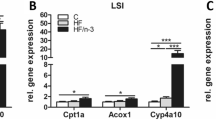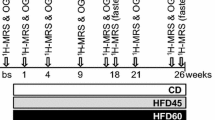Abstract
High-fat diets (HFD) are commonly used in rodents to induce obesity, increase serum fatty acids and induce lipotoxicity in various organs. In vitro studies commonly utilize individual free fatty acids (FFA) to study lipid exposure in an effort to model what is occurring in vivo; however, these approaches are not physiological as tissues are exposed to multiple fatty acids in vivo. Here we characterize circulating lipids in obesity-prone rats fed an HFD in both fasted and fed states with the goal of developing physiologically relevant fatty acid mixtures for subsequent in vitro studies. Rats were fed an HFD (60 % kcal fat) or a control diet (10 % kcal fat) for 3 weeks; liver tissue and both portal and systemic blood were collected. Fatty acid profiles and absolute concentrations of triglycerides (TAG) and FFA in the serum and TAG, diacylglycerol (DAG) and phospholipids in the liver were measured. Surprisingly, both systemic and portal serum TAG were ~40 % lower in HFD-fed compared to controls. Overall, compared to the control diet, HFD feeding consistently induced an increase in the proportion of circulating polyunsaturated fatty acids (PUFA) with a concomitant decline in monounsaturated fatty acids (MUFA) and saturated fatty acids (SFA) in both serum TAG and FFA. The elevations of PUFA were mostly attributed to increases in n-6 PUFA, linoleic acid and arachidonic acid. In conclusion, fatty acid mixtures enriched with linoleic and arachidonic acid in addition to SFA and MUFA should be utilized for in vitro studies attempting to model lipid exposures that occur during in vivo HFD conditions.







Similar content being viewed by others
Abbreviations
- DAG:
-
Diacylglycerol(s)
- FFA:
-
Non-esterified fatty acids
- MAG:
-
Monoacylglycerol(s)
- MUFA:
-
Monounsaturated fatty acid(s)
- PL:
-
Phospholipids
- PUFA:
-
Polyunsaturated fatty acid(s)
- SFA:
-
Saturated fatty acid(s)
- TAG:
-
Triacylglycerol(s)
References
Kewalramani G, Bilan PJ, Klip A (2010) Muscle insulin resistance: assault by lipids, cytokines and local macrophages. Curr Opin Clin Nutr Metab Care 13:382–390
Szendroedi J, Roden M (2009) Ectopic lipids and organ function. Curr Opin Lipidol 20:50–56
O’Rourke AT, Peacock M, Samuel JE, Frazier ME, Natvig DO, Mallavia LP, Baca O (1985) Genomic analysis of phase I and II Coxiella burnetii with restriction endonucleases. J Gen Microbiol 131:1543–1546
Cusi K (2012) Role of obesity and lipotoxicity in the development of nonalcoholic steatohepatitis: pathophysiology and clinical implications. Gastroenterology 142(711–725):e716
Mortiaux A, Dawson AM (1961) Plasma free fatty acid in liver disease. Gut 2:304–309
Bjorntorp P, Bergman H, Varnauskas E (1969) Plasma free fatty acid turnover rate in obesity. Acta Med Scand 185:351–356
Yuan G, Al-Shali KZ, Hegele RA (2007) Hypertriglyceridemia: its etiology, effects and treatment. CMAJ 176:1113–1120
Brunzell JD (2007) Clinical practice. Hypertriglyceridemia. N Engl J Med 357:1009–1017
Lee H, Lee H, Cho J, Stampfer M, Willett W, Kim C, Cho E (2013) Overall and abdominal adiposity and hypertriglyceridemia among Korean adults: the Korea National Health and Nutrition Examination Survey 2007–2008. Eur J Clin Nutr 67:83–90
Reaven GM (2005) The insulin resistance syndrome: definition and dietary approaches to treatment. Annu Rev Nutr 25:391–406
Lumeng CN, Saltiel AR (2011) Inflammatory links between obesity and metabolic disease. J Clin Investig 121:2111–2117
Ontko JA (1972) Metabolism of free fatty acids in isolated liver cells. Factors affecting the partition between esterification and oxidation. J Biol Chem 247:1788–1800
Patsch W, Tamai T, Schonfeld G (1983) Effect of fatty acids on lipid and apoprotein secretion and association in hepatocyte cultures. J Clin Investig 72:371–378
de Almeida IT, Cortez-Pinto H, Fidalgo G, Rodrigues D, Camilo ME (2002) Plasma total and free fatty acids composition in human non-alcoholic steatohepatitis. Clin Nutr 21:219–223
Bysted A, Holmer G, Lund P, Sandstrom B, Tholstrup T (2005) Effect of dietary fatty acids on the postprandial fatty acid composition of triacylglycerol-rich lipoproteins in healthy male subjects. Eur J Clin Nutr 59:24–34
Firl N, Kienberger H, Hauser T, Rychlik M (2012) Determination of the fatty acid profile of neutral lipids, free fatty acids and phospholipids in human plasma. Clin Chem Lab Med 0:1–12
Chavez JA, Summers SA (2003) Characterizing the effects of saturated fatty acids on insulin signaling and ceramide and diacylglycerol accumulation in 3T3-L1 adipocytes and C2C12 myotubes. Arch Biochem Biophys 419:101–109
Gorgani-Firuzjaee S, Bakhtiyari S, Golestani A, Meshkani R (2012) Leukocyte antigen-related inhibition attenuates palmitate-induced insulin resistance in muscle cells. J Endocrinol 215:71–77
Jung TW, Lee KT, Lee MW, Ka KH (2012) SIRT1 attenuates palmitate-induced endoplasmic reticulum stress and insulin resistance in HepG2 cells via induction of oxygen-regulated protein 150. Biochem Biophys Res Commun 422:229–232
Savary S, Trompier D, Andreoletti P, Le Borgne F, Demarquoy J, Lizard G (2012) Fatty acids induced lipotoxicity and inflammation. Curr Drug Metab 13:1358–1370
Lima TM, Kanunfre CC, Pompeia C, Verlengia R, Curi R (2002) Ranking the toxicity of fatty acids on Jurkat and Raji cells by flow cytometric analysis. Toxicol In Vitro Int J Publ Assoc BIBRA 16:741–747
Folch J, Lees M, Sloane Stanley GH (1957) A simple method for the isolation and purification of total lipides from animal tissues. J Biol Chem 226:497–509
Borengasser SJ, Rector RS, Uptergrove GM, Morris EM, Perfield JW 2nd, Booth FW, Fritsche KL, Ibdah JA, Thyfault JP (2012) Exercise and omega-3 polyunsaturated fatty acid supplementation for the treatment of hepatic steatosis in hyperphagic OLETF rats. J Nutr Metab 2012:268680
Heden TD, Morris EM, Kearney ML, Liu TW, Park YM, Kanaley JA, Thyfault JP (2014) Differential effects of low-fat and high-fat diets on fed-state hepatic triacylglycerol secretion, hepatic fatty acid profiles, and DGAT-1 protein expression in obese-prone Sprague–Dawley rats. Appl Physiol Nutr Metab Physiol Appl Nutr Metab 39:472–479
Paton CM, Ntambi JM (2009) Biochemical and physiological function of stearoyl-CoA desaturase. Am J Physiol Endocrinol Metab 297:E28–E37
Hofacer R, Magrisso IJ, Jandacek R, Rider T, Tso P, Benoit SC, McNamara RK (2012) Omega-3 fatty acid deficiency increases stearoyl-CoA desaturase expression and activity indices in rat liver: positive association with non-fasting plasma triglyceride levels. Prostaglandins Leukot Essent Fat Acids 86:71–77
Stamatikos AD, Paton CM (2013) Role of stearoyl-CoA desaturase-1 in skeletal muscle function and metabolism. Am J Physiol Endocrinol Metab 305:E767–E775
Jackman MR, Kramer RE, MacLean PS, Bessesen DH (2006) Trafficking of dietary fat in obesity-prone and obesity-resistant rats. Am J Physiol Endocrinol Metab 291:E1083–E1091
Karpe F, Dickmann JR, Frayn KN (2011) Fatty acids, obesity, and insulin resistance: time for a reevaluation. Diabetes 60:2441–2449
Johnson GH, Fritsche K (2012) Effect of dietary linoleic acid on markers of inflammation in healthy persons: a systematic review of randomized controlled trials. J Acad Nutr Diet 112:1029–1041
Hihi AK, Michalik L, Wahli W (2002) PPARs: transcriptional effectors of fatty acids and their derivatives. Cell Mol Life Sci CMLS 59:790–798
Varga T, Czimmerer Z, Nagy L (2011) PPARs are a unique set of fatty acid regulated transcription factors controlling both lipid metabolism and inflammation. Biochim Biophys Acta 1812:1007–1022
Georgiadi A, Kersten S (2012) Mechanisms of gene regulation by fatty acids. Adv Nutr 3:127–134
Ntambi JM, Miyazaki M, Stoehr JP, Lan H, Kendziorski CM, Yandell BS, Song Y, Cohen P, Friedman JM, Attie AD (2002) Loss of stearoyl-CoA desaturase-1 function protects mice against adiposity. Proc Natl Acad Sci USA 99:11482–11486
Warensjo E, Riserus U, Vessby B (2005) Fatty acid composition of serum lipids predicts the development of the metabolic syndrome in men. Diabetologia 48:1999–2005
Bjermo H, Riserus U (2010) Role of hepatic desaturases in obesity-related metabolic disorders. Curr Opin Clin Nutr Metab Care 13:703–708
Flowers MT, Ntambi JM (2009) Stearoyl-CoA desaturase and its relation to high-carbohydrate diets and obesity. Biochim Biophys Acta 1791:85–91
Chong MF, Hodson L, Bickerton AS, Roberts R, Neville M, Karpe F, Frayn KN, Fielding BA (2008) Parallel activation of de novo lipogenesis and stearoyl-CoA desaturase activity after 3 d of high-carbohydrate feeding. Am J Clin Nutr 87:817–823
Li ZZ, Berk M, McIntyre TM, Feldstein AE (2009) Hepatic lipid partitioning and liver damage in nonalcoholic fatty liver disease: role of stearoyl-CoA desaturase. J Biol Chem 284:5637–5644
Holland WL, Summers SA (2008) Sphingolipids, insulin resistance, and metabolic disease: new insights from in vivo manipulation of sphingolipid metabolism. Endocr Rev 29:381–402
Ervin RB, Wright JD, Wang CY, and Kennedy-Stephenson J (2004) Dietary intake of fats and fatty acids for the United States population: 1999–2000. Adv Data (348):1–6
Acknowledgments
This work was funded by the National Institutes of Health [NIH R01DK088940 (JPT)] and 5T32 AR-48523-8 (EMM). This work was also completed in part with resources from the Research Services Department of the Harry S. Truman Memorial Veterans Hospital. We would like to thank Abiezer Blandon, Grace M. Meers, Melissa A. Linden and Justin A. Fletcher for their help and technical assistance with this study.
Author information
Authors and Affiliations
Corresponding author
Ethics declarations
Conflict of interest
The authors have no conflicts of interest, financial or otherwise, to disclose for this research.
Electronic supplementary material
Below is the link to the electronic supplementary material.
About this article
Cite this article
Liu, TW., Heden, T.D., Matthew Morris, E. et al. High-Fat Diet Alters Serum Fatty Acid Profiles in Obesity Prone Rats: Implications for In Vitro Studies. Lipids 50, 997–1008 (2015). https://doi.org/10.1007/s11745-015-4061-5
Received:
Accepted:
Published:
Issue Date:
DOI: https://doi.org/10.1007/s11745-015-4061-5




